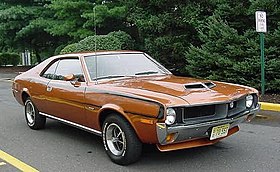AMC Javelin
| AMC Javelin | |
|---|---|

1971 AMC Javelin SST
|
|
| Overview | |
| Manufacturer | American Motors Corporation (AMC) |
| Also called |
|
| Production | 1967 – 1974 |
| Assembly |
|
| Designer | Richard A. Teague |
| Body and chassis | |
| Class | |
| Body style | 2-door hardtop |
| Layout | FR layout |
| Platform | AMC’s "junior" cars |
| 1968 and 1969 | |
|---|---|

1968 AMC Javelin base model
|
|
| Overview | |
| Also called | IKA Mica (Argentina) Rambler Javelin (Australia) VAM Javelin (Mexico) |
| Production | August 1967 – July 1969 |
| Designer | Richard A. Teague |
| Body and chassis | |
| Related | AMC AMX |
| Powertrain | |
| Engine |
|
| Transmission | 3-speed manual 4-speed manual 3-speed automatic 3-speed “Shift-Command” on console |
| Dimensions | |
| Wheelbase | 109 in (2,769 mm) |
| Length | 189.2 in (4,806 mm) |
| Width | 71.9 in (1,826 mm) |
| Height | 51.8 in (1,315.7 mm) |
| Curb weight | 2,836 lb (1,286.4 kg) |
| 1970 | |
|---|---|

1970 AMC Javelin SST with “Go Package”
|
|
| Overview | |
| Also called | Rambler Javelin (Australia) VAM Javelin (Mexico) |
| Production | August 1969 - July 1970 |
| Powertrain | |
| Engine |
|
| Transmission | 3-speed manual 4-speed manual 3-speed automatic 3-speed “Shift-Command” on console |
| Dimensions | |
| Wheelbase | 110 in (2,794 mm) |
| Length | 191.04 in (4,852 mm) |
| 1971 – 1974 | |
|---|---|

1974 AMC Javelin AMX with "Go Package"
|
|
| Overview | |
| Also called | IKA Mica (Argentina) Rambler Javelin (Venezuela & Australia) VAM Javelin (Mexico) |
| Production | August 1970 – 1974 |
| Powertrain | |
| Engine |
|
| Transmission | 3-speed manual 4-speed manual 3-speed automatic 3-speed “Torque-Command” on console |
| Dimensions | |
| Wheelbase | 109 in (2,769 mm) |
| Length | 191.8 in (4,872 mm) |
| Curb weight | 2,875 lb (1,304.1 kg) - 3,184 lb (1,444.2 kg) |
The AMC Javelin is an American front-engine, rear-wheel-drive, two-door hardtop manufactured and marketed by AMC in two generations, 1968–70 and 1971–74. Styled by Dick Teague, the Javelin was available in a range of trim and engine levels, from economical pony car to muscle car variants. In addition to manufacture in Kenosha, Wisconsin, Javelins were assembled under license in Germany, Mexico, Venezuela, as well as Australia – and were marketed globally.
As the winner of Trans-Am race series in 1971, 1972, and 1976, the second-generation AMX variant was the first pony car to be used as a standard vehicle for highway police car duties by an American law enforcement agency.
American Motors' Javelin served as the company's entrant into the "pony car" market created by the Ford Mustang. The design evolved from two AMX prototypes shown in AMC's "Project IV" concept cars during 1966. One was a fiberglass two-seat "AMX", and the other was a four-seat "AMX II". Both of these offerings reflected the company's strategy to shed its "economy car" image and appeal to a more youthful, performance-oriented market.
Sales of convertibles were dropping and AMC did not have the resources to design separate fastback and notchback hardtops that were available on the Mustang and on the second-generation Plymouth Barracuda, so the AMC designer team under Richard A. Teague penned only one body style, "a smooth semi-fastback roofline that helped set Javelin apart from other pony cars."
The Javelin was built on AMC's "junior" (compact) Rambler American platform only as a two-door hardtop model to be a "hip", dashing, affordable pony car, as well as available in muscle car performance versions. "Despite management's insistence on things like good trunk space and rear-seat room, Teague managed to endow the Javelin with what he termed the wet T-shirt look: voluptuous curves with nary a hint of fat."
...
Wikipedia
